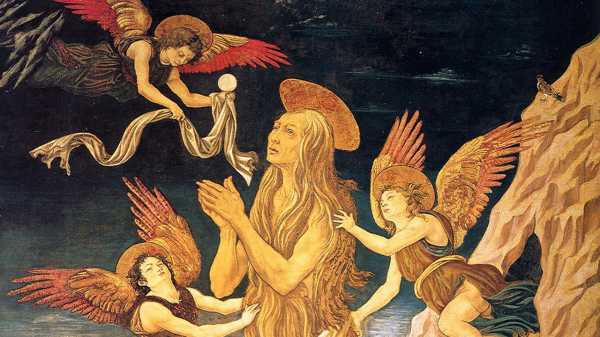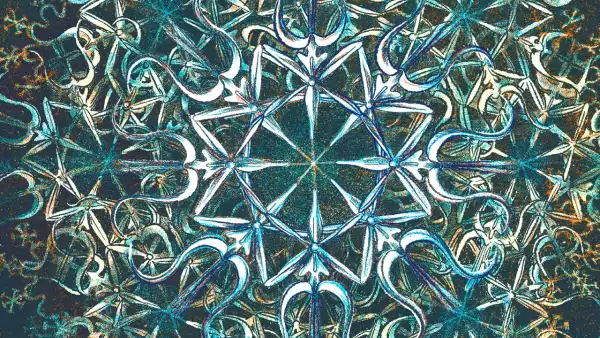
Save this storySave this storySave this storySave this story
An ancient depiction of a naked woman hung on the wall of my father’s study. Skeletal, stupefied, and wildly bedheaded, she contemplated distances across time and space, as saints and mystics do. As with many of the unsettling religious tchotchkes scattered around the rectory where I spent my childhood, I didn’t give much thought to the unkempt icon, until more recently, when I grew curious about Mary Magdalene and began to read into the controversies swirling around her.
Magdalene is the most famous woman in Christianity after Jesus’ mother; she is also arguably the most hotly contested figure in the New Testament. A companion to Jesus in all four Gospels, she is present at his tomb, and, in some versions, is the first to see him after his Resurrection. In the Book of John, Jesus commissions her to share the good news of his return with the other disciples, which is why Thomas Aquinas, the thirteenth-century theologian, names her “the apostle to the apostles.” Nonetheless, Magdalene has been maligned by Church fathers throughout the centuries; in the present day, feminist scholars have championed her.
Magdalene, appearing in scripture only fourteen times, belongs to a tangle of at least six women named Mary. This multitude of Marys leaves considerable room for disagreement over which Biblical threads are authentically woven into Magdalene’s story, and which aren’t. In the Eastern Orthodox Church, she has a long and unassailed history of veneration. In the West, she’s been sanctified, but also portrayed as a sinner, a nun, a mystic, and Jesus’ wife. She remains, above all, a liminal figure. The patron saint of outcasts, she embodies uncertainty.
“There are so many disparate stories,” Elaine Pagels, the renowned religious scholar, told me on the sunporch of her home, in Princeton, New Jersey. To underscore the point, Pagels went to fetch a copy of “The New Oxford Annotated Bible,” flipping between the Books of Matthew, Mark, Luke, and John, and pausing over discrepancies between their Magdalene narratives. “The writers of the New Testament didn’t seem much interested in women except in their subsidiary roles,” she said. She poked around in the Book of Luke to show me how the author diminished Mary Magdalene’s significance. She’s present at the Resurrection, but only among other women. Instead of encountering the risen Lord, these women see two angels. “Luke deprecates her role,” Pagels said.
Pagel’s expertise, however, stretches far beyond the four Gospels that, by the start of the fifth century, had become the official canon. She has explored a much larger body of texts, many of which include women in more authoritative roles. Consider, she suggested, the Gospel of Philip—a third-century text discovered with similar documents near Nag Hammadi, in Egypt, in 1945—in which Magdalene is described as the woman “who always walked with the Lord” and “the one who was called his companion.” In its telling, her expansive influence transcends the terrestrial. As Pagels put it, “She’s seen as a manifestation of divine wisdom.”
Along with icons of anorexic saints, my childhood home was a place of books. Pagels’s “The Gnostic Gospels” shared a shelf with “The Complete Poems of Emily Dickinson” and Carl Jung’s “Memories, Dreams, Reflections.” Each, in its own way, invited a friendly skepticism of orthodoxy and imbued value in people and ideas previously relegated to the edge. As Dickinson writes, “Tell all the truth but tell it slant.”
Mary Magdalene is a cipher for slantwise truth; to engage with her story requires divine imagination. Beyond the scant scriptural references, a rich treasury of myth can be found. My favorite, a thirteenth-century French narrative known as the Golden Legend, features Magdalene and Jesus’ friend Lazarus, who in this and some other accounts is said to be her brother. With a handful of followers, the two board a boat fourteen years after Jesus’ crucifixion and land on the southern coast of France. There, Magdalene lives and teaches until her death. Two duelling French monasteries still claim to hold her relics. On July 22nd, her feast day, they venerate her as their patron saint.
Magdalene is rendered more complex by associations with sexual desire: in the popular imagination, she’s a repentant prostitute. Yet, as I read more about who Mary Magdalene was, I was startled to learn that nothing in the New Testament associates her with licentiousness. Instead, this claim originated in a series of sermons given by Pope Gregory in 591. Gregory argued that Magdalene should be understood as highly sinful, referring to a story, in the Book of Luke, in which Jesus exorcised seven demons from her body. (Feminist scholars have questioned this interpretation, raising the possibility that Magdalene’s seven demons reflect the Eastern concept of seven chakras rather than a sinful nature. Maybe Jesus was clearing Magdalene’s chakras.)
Pope Gregory, believing these demons to be an indication of Magdalene’s excessively sinful past, identified her as an unnamed woman in Luke who wipes Jesus’ feet with her hair. Each of the four canonical Gospels recounts a version of this story, of a woman who, much to the frustration of the disciples, empties an expensive alabaster jar of unguent in order to anoint Jesus before he dies. In Matthew, Mark, and John, the disciples complain to Jesus that the costly perfume—which was called nard and derived from a kind of honeysuckle—could have been sold to raise money to feed the poor. Pope Gregory emphasized the nard as proof that Magdalene was a prostitute, claiming that the expensive perfume masked the stink of the sex trade.
Gregory, who became known as Gregory the Great, had reasons to advance such an argument. A reforming figure who led the Church during a time of plague, Gregory was an aristocrat, who had renounced his wealth and become celibate. (Women were linked to sin through carnal desire.) As James Carroll, the author of “Constantine’s Sword” and a former Catholic priest, has noted, the key to understanding these sermons is understanding Gregory’s intended audience, which was male: Gregory calls his listeners “brothers.” In identifying Magdalene as the unnamed woman, Gregory succeeded in helping to marginalize women in the Church for the next fourteen hundred years.
In 1969, the Catholic Church went so far as to apologize for advancing this claim, but the power of the association was so strong that many people still hold the mistaken belief that Magdalene was a prostitute. I’m slightly embarrassed to say that I was one of them, until several years ago, when I began reading about Magdalene and learned what Pope Gregory had done. Disgusted by history and dismayed by my own ignorance, I went to chat with my father, a retired Episcopal bishop and a student of early-Christian tradition. At the time, he was also my neighbor, and I found him at the kitchen table, eating his breakfast of steel-cut oats. There was more to contending with the myth of Magdalene than dispelling Pope Gregory’s assertion, he told me. This was also an ancient case of mistaken identity.
Disappearing from the table, my father returned with that eerie icon of the naked woman. Her name, he explained, was Mary of Egypt, and she was, tradition holds, a fifth-century street prostitute. My dad revered Mary of Egypt, who was also known as the Harlot of the Desert, and was largely forgotten in the West. He’d come to know of her while travelling to monasteries in the Jordan Valley, and he proposed that we take a trip to one of them, called St. Gerasimos, together. This was the spring of 2020, however, and the impossibilities of international travel, and my dad’s frail health, delayed the journey.
I kept delving into Mary of Egypt. Curiously enough, a scholar and a friend of mine, Amy Frykholm, had recently written a book about her, “Wild Woman: A Footnote, the Desert, and My Quest for an Elusive Saint,” in which Frykholm translates from the Greek a seventh-century chronicle of Mary’s life. The scribe writes about Mary of Egypt living in doorways in the city of Alexandria for seventeen years, until one day she spies several young men who are “vigorous in their bodies and their movements,” running to board a ship. She asks who they might be and discovers that they are Christian pilgrims on their way to Jerusalem.
Over the phone, Frykholm read aloud to me some of the passages that she had translated. “I am going to go up into one of those boats they have hired, and they will take care of me, even if they don’t want to,” the scribe reports Mary saying. “For I have this body that they will receive instead of passage.” The sexually explicit nature of the text startled me and provoked a laugh. After paying for her passage in sexual favors, Mary of Egypt arrived in Jerusalem. Yet when she attempted to accompany the pilgrims inside the Church of the Holy Sepulchre, which sits on the storied site of Jesus’ Crucifixion and burial, she found herself barred from entering the church by a mysterious force. “She pushes and she shoves and she tries to get in, but she can’t,” Frykholm said. Then Mary of Egypt heard a voice calling her to cross the River Jordan into the desert. There, she lived as a hermit. Her clothes fell to shreds. Her flesh wasted away. Eventually, only her long locks covered her body, as, for forty-seven years, she prayed.
“Tradition has her an icon of repentance, but to me it’s much more interesting to view her as an icon of desire,” Frykholm said. “For her, one desire leads to another desire, and then this leads her to God.” Finally, in the desert, a monk named Zosimas encountered her. Zosimas, in the throes of a spiritual crisis, was seeking a wise man to give him counsel; he met Mary of Egypt, instead. “The great moment of the story is he’s going in search of a desert father, and finds a mother,” Frykholm said.
No one knows for sure what monastery Zosimas came from, but the monks of St. Gerasimos, which lies a few miles away, claim him as a spiritual father. This was why my father wanted to take me to St. Gerasimos, so that I could hear the story of Zosimas and Mary of Egypt directly from the monks. We never made it. My dad’s health continued to falter, and when he died, two years ago, I stopped sleuthing among the Marys. It had principally been a way to play with my dad, who found humor in the human errors that are rife in supposed matters of Biblical certainty. “Divine truth can as easily be revealed through myth and poetry as it can be through literal truth,” my dad liked to say, paraphrasing Charles Gore, a Bishop of Oxford.
Before my father died, he pointed out one more error by which Mary Magdalene had become entwined with Mary of Egypt. It began with the ancient naked icon. During the course of centuries, this image of a shriven prostitute became conflated with Magdalene. In approximately 1455, the Italian master Donatello carved a wooden figure called the “Penitent Magdalene”: emaciated, barefooted, and dressed in what looks like feathers but is, in fact, hair. In 1460, Antonio del Pollaiuolo followed suit, painting Magdalene ascending to heaven as a kind of human sheepdog with well-muscled arms. Around the year 1565, the Venetian Renaissance painter Titian updated the “Penitent Magdalene,” representing her as a zaftig figure with milky skin, her eyes still cast skyward in prayer, corkscrew curls cascading into her décolletage. A decade later, El Greco depicted his Penitent Magdalene with a nipple peeking out.
This visual narrative, of Magdalene as a half-naked woman in prayerful penance, continues through Caravaggio’s sexy and ambiguous “Mary Magdalen in Ecstasy,” from 1606, and Peter Paul Rubens’s tableau “Christ and Penitent Sinners,” in which a foregrounded Magdalene, wound in tresses of her hair, kneels at Jesus’ feet. In December, 2024, the Italian art restorer and researcher Sara Penco discovered a figure she argues is Mary Magdalene on the ceiling of the Sistine Chapel. In Michelangelo’s version, Magdalene’s golden hair flows over her shoulders, exposing a bony clavicle as she leans forward to kiss the cross.
The most intriguing elements of Magdalene’s story remain the most mysterious. Among them is a Gospel written in her name, first discovered in a Cairo bazaar in the late eighteen-hundreds. Although, like so many Biblical narratives, the Gospel of Mary was excluded from the canon, scholars contend that the text was in wide circulation among Jesus’ early followers.
What I love most about the Gospel of Mary is how it ends: with an argument. After Jesus’ death, Mary Magdalene comes to his disciples to tell them that he has given her secret teachings. But Andrew and Peter question whether Jesus would really have done such a thing. “How is it possible that the Teacher talked in this manner with a woman about secrets of which we ourselves are ignorant?” Peter asks. “Must we change our customs and listen to this woman? Did he really choose her and prefer her to us?”
On close reading, this is funny. Peter isn’t just questioning her; he’s complaining about how much work the disciples will be required to do if they have to change their practices based on these new teachings. In response, Magdalene begins to cry. The Coptic gives us, “Mary wept.” The sentence mirrors the moment that Jesus wept when he found out that Lazarus had died. Her tears seem to soften the disciples, who listen as Mary Magdalene begins to lay out the teachings. She recounts asking Jesus how to reach God: through the psyche or the spirit? Neither, Jesus tells her. God speaks to us through what Jesus calls the nous, which is often translated from the Greek as “mind,” but is perhaps more accurately thought of as consciousness.
This alternative vision of Mary Magdalene as a companion to Jesus and as a spiritual teacher lends itself to modern interpretation. One summer evening, I joined Meggan Watterson—a Magdalene scholar who holds a degree from the Harvard Divinity School—at MNDFL, a meditation gym in Brooklyn. The author of the book “Mary Magdalene Revealed,” Watterson was there to offer the ancient instructions of Mary’s secret gospel. Beyond an airy entry hall, where the gym sold turmeric tea and pricey strands of prayer beads, about thirty women leaned against black BackJacks or sat upright on meditation cushions. Watterson, with her chin dropped to her chest, directed the group to glance into their hearts to search for the nous, much as she believed the ancient group of Christians called the Hesychasts did. The practice allowed the meditators to view their devotion as closely tied to Magdalene. “I’m always intrigued by how people identify with Biblical characters, whether it’s Jesus’ mother or Mary Magdalene,” Pagels told me. “It’s an intimate relationship. They become like family members.”
Authenticity, however, like certainty, can be a trap. For serious scholars, cautionary tales surrounding claims of Mary Magdalene abound. None is more painful than that of Karen L. King, the Hollis Professor of Divinity at Harvard Divinity School, who, in 2012, held a press conference near the Vatican to announce the discovery of an ancient papyrus fragment. The fragment, which she called the Gospel of Jesus’ Wife, substantiated her theory that Mary Magdalene may have been Jesus’ confidant and disciple. The papyrus scrap contained only fourteen lines. Many were broken. It read, “Jesus said to them, ‘My wife . . .’ ” It went on, “She is able to be my disciple.” King argued that there seemed to be enough evidence to suggest that Jesus was speaking of Mary Magdalene, and probably defending her authority to a group of men. In 2016, a journalist named Ariel Sabar revealed that the fragment was almost certainly a fake, crafted, perhaps, to draw in King specifically, because her hypothesis about Magdalene’s role in Jesus’ life was well known. After reading Sabar’s investigation, King acknowledged that it “tips the balance towards forgery.”
More recently, after publishing part of her master’s thesis in the Harvard Theological Review, a relatively new Magdalene scholar, Elizabeth Schrader Polczer, has garnered significant attention. Based on her reading of Papyrus 66, thought to be the world’s oldest complete copy of the Gospel of John, and other crucial manuscripts, Schrader Polczer, an assistant professor of New Testament at Villanova University, argues that a second-century scribe deliberately suppressed the role of Mary Magdalene. A textual analysis of John 11 and 12, in which Jesus travels to the city of Bethany to visit Lazarus’s family, shortly after his friend’s death, reveals “some very strange scribal activity,” Schrader Polczer said. Her scholarship has helped decipher some largely forgotten clues in the ancient papyrus, discovered in Egypt in the early nineteen-fifties, about why a woman’s name has been crossed out and her character split in two.
Schrader Polczer followed an unlikely path to becoming a Biblical scholar. A former singer-songwriter from Portland, Oregon, she won the first Pantene Pro-Voice competition, in 2001, several months after graduating from Pomona College. That summer, as part of the prize, Schrader Polczer, who went by the name Libbie Schrader, opened for the pop star Jewel onstage in New York City’s Central Park, performing a song called “Blood Red Moon.” “It was about a late period,” Schrader Polczer told me.
Schrader Polczer moved to Brooklyn and spent the next decade trying to break through in the music business. She had some successes—she appeared on an episode of “Gilmore Girls”—but mostly supported herself by teaching piano and playing college gigs. Facing a professional crossroads, Schrader Polczer, who’d been baptized in the Episcopal Church, walked through the wrought-iron gates of the Co-Cathedral of St. Joseph, in Prospect Heights. There, she prayed in the garden, surrounded by disintegrating statues of Jesus’ mother. Asking for direction, she heard a clear, if surprising, response: “Maybe you should talk to Mary Magdalene about that!” In 2011, she began working on an album called “Magdalene.” In a music video for the title track, Schrader Polczer, wearing jeans and a white crocheted top, returns to the cathedral churchyard “to ask for the blessing of the Magdalene,” as her title song instructs. She sings,
She’s a bleeding heart full of blinding light
Which she carefully conceals ’til the time is right
Oh, a woman heavy with the dark of night
She will do, allelu, what she came here to do.
She is ready now to do what she came to do.
The writing of the song came quickly and easily, but Schrader Polczer wanted to ground her enthusiasm in historical context. “I can’t make a record called ‘Magdalene’ and not really know anything about Mary Magdalene,” she said. So Schrader Polczer went to the Brooklyn Public Library and checked out “The Complete Idiot’s Guide to Mary Magdalene,” by Lesa Bellevie. It’s actually really good,” she told me. The book laid out, in scholarly detail, competing narratives about who Mary Magdalene was.
One of the most heated debates centered on whether Mary Magdalene is indeed the same Mary who is the sister of Lazarus, a figure scholars often refer to as Mary of Bethany. This matters because if Mary Magdalene and Mary of Bethany are the same person, then Magdalene’s role in scripture grows more significant: she is the woman who anoints Jesus in John.
To consider this question and others, Schrader Polczer wanted to return to the world’s oldest surviving copy of John, to see exactly how the first anonymous scribes set down the story. Yet when Schrader Polczer first pulled up the transcription of Papyrus 66 on her computer screen, she realized that it was in Greek, which she didn’t yet read. So she set about going through the text line by line with an interlinear study Bible. As she examined the Greek characters, she noticed that the anonymous scribe had made a series of changes. “There are four hundred and fifty corrections throughout the manuscript,” she said. One set of alterations caught Schrader Polczer’s attention: in the story of Jesus raising Lazarus from the dead, she could see that the scribe had changed a woman’s name. In a crucial passage, the name Mary had been altered to Martha, by crossing out the Greek letter “I,” iota, and replacing it with a “th,” theta.
In other places, the verb agreements had also been changed from singular to plural, indicating that one named woman had been split into two unnamed women, called “the sisters.” “It looked like Martha was getting added to the story,” Schrader Polczer said. “To my total uneducated eye, it looked like an editor might be trying to dilute the role of Lazarus’s sister Mary.” Through interlibrary loan, she went looking for previous scholarship related to these textual discrepancies, and came across the work of the late Gordon Fee, a theologian and a scholar, who had begun to ask similar questions in the nineteen-sixties.
Once Schrader Polczer found the correction in Papyrus 66, she set about contacting famous New Testament scholars, who she hoped might consider investigating the matter. She wrote to Karen King and attended a talk that Pagels gave at St. Thomas Church in New York City. As Pagels was leaving the stage, Schrader approached with a printout of the transcription. (Pagels, who doesn’t recall the encounter, noted that she is often approached in unconventional ways. “I got a call from John the Baptist once claiming he’d written the Book of Revelation,” she told me.)
Finally, a friend advised Schrader Polczer to become the scholar she was seeking. So, she returned to school, and earned two master’s degrees from the General Theological Seminary in New York and a Ph.D. in early Christianity and New Testament from Duke University. She made other discoveries, which contributed to her sense that Mary Magdalene had been “diluted” in the Gospel of John. There was her name, Magdalene, which many scholars took as a reference to a fishing village on the Sea of Galilee. “Nobody said she came from a place called Magdala until the sixth century,” she said. More likely, she surmised, “Magdala” was a reference to the Aramaic word for “tower,” as in Mary Magdalene was a tower in the Church, much as the apostle Peter is referred to as the rock. “The figure of Peter has become a cipher for orthodoxy,” she said. “Mary Magdalene—more of a cipher for direct, visionary experience.”
Over time, Church fathers apparently favored Peter’s influence in the early text at the expense of Mary Magdalene. Jesus, before raising Lazarus from the dead, famously declares to Lazarus’s sister—Martha, in the edited text—“I am the resurrection and the life. Those who believe in me, even though they die, will live, and everyone who lives and believes in me will never die. Do you believe this?” “Yes, Lord,” the sister replies, “I believe that you are the Messiah, the Son of God, the one coming into the world.” This declaration, called a Christological confession, signifies one of the rare moments in the Bible when a follower of Jesus recognizes who he truly is. When a woman, who some scholars suspect is Mary Magdalene, is erased from this passage in John 11, her role is significantly diminished; it is Peter, the first apostle to recognize Jesus, who comes to the fore in Matthew, Mark, and Luke and whose name is passed down through history.
Finding the alterations to the Greek manuscript hard to parse in the abstract, I asked Schrader Polczer to meet in person so that she could walk me through them on the page. We met on a brilliantly sunny pre-spring afternoon in Croydon, a Pennsylvania town she’d selected as roughly midway between Villanova, where she teaches, and Princeton, where I direct the journalism program.
Schrader Polczer, wearing a large black straw hat, an early nod to an Easter bonnet, sat on a bench by the bank of the Delaware River and opened her laptop. These photographs of Papyrus 66 were taken in the fifties, she told me, showing me an image of a fat stack of flattened reeds, its frangible leaves resembling flaky layers of pastry. She clicked forward to another image and zoomed in, showing me where the name Maria had clearly been made into Martha. “See this?” Schrader Polczer asked. She pointed to another group of scraggly letters: the phrase “the sisters” had been superimposed over another word that was now impossible to read but included the Greek letters that correspond to “R” and “A.” It was definitely a woman’s name; Schrader Polczer hypothesized that it was likely Mary. “A woman has definitely been split in two and her name has been erased in Verse 3 of John 11,” she said. Whatever might be inferred from these changes, her findings are now cited in commentary about the Gospel of John and have inspired a lively debate in current scholarship.
Schrader Polczer’s claims, however, go beyond those of a historian. Mary Magdalene’s more central role in this gospel, she intuits, has been hidden for a reason: if she’d been too strong a figure, and challenged the dominant narrative of Peter, then the Book of John may have been left out of the Bible, and dismissed as heretical. “Maybe this made John suitable for the canon,” she said. Magdalene, as Schrader Polczer sees it, is sacrificed in scripture and in history, erased so that she can now be revealed. “It’s not just Lazarus who is ill,” she told me, as we sat together on the bench. “There’s an illness in the text.” She perceived the likely elision of Magdalene as a “wounding,” of the text itself, and Magdalene’s willingness to allow herself to be erased as an example of Jesus’ famous invitation to his followers to “lay down their lives for their friends.” The revelations she has uncovered have also had profound spiritual relevance in her life. “Doing this work has deepened my faith,” she told me. “The Gospel of John is known as the Gospel of Signs, and I think it might have one more sign for us.”
Driving home that afternoon, I considered how risky it seemed for a budding academic to tie her work to the idea of divine revelation. Yet faith, as the twentieth-century theologian Paul Tillich said, requires risk. Perhaps speaking in such terms to a journalist struck Schrader Polczer as risky, also. Soon after we parted ways, she texted me. “Just one last thing I should probably add—when talking about theology stuff like the wounded word, Mary laying down her life for her friends, the gospel has one more ‘sign’ etc., that’s me with my theology hat on. It’s different than me as a historian.” I admired her for being honest, and for sharing so much of herself. Mary Magdalene, as the patron saint of outcasts, seemed to draw them in, welcoming skeptics like me to make room in our minds for more complex possibilities.
Heading north along Route 1, I considered the journey I’d never taken with my father. Admittedly, Shake Shack and Ski Barn were less evocative landmarks than the ancient monasteries and archeological sites we would’ve seen. And yet these were landmarks on another kind of journey I’d carried forward on my own, though not alone. As I formed ideas, I was aware that I was still in conversation with my dad. I recalled his integrity, intellect, and devilish sense of humor, and felt the presence of those qualities in me. Magdalene, like Mary of Egypt, delighted him and still delights me, not in the form of some fixed new idea but in the multitude of disruptive possibilities she offers. The depictions of the Penitent Magdalene are no less striking for their transformation over time, through each artist’s imagination—or for beginning with the wrong Mary. ♦
Sourse: newyorker.com







